technical specifications FIAT LINEA 2007 1.G Owners Manual
[x] Cancel search | Manufacturer: FIAT, Model Year: 2007, Model line: LINEA, Model: FIAT LINEA 2007 1.GPages: 230, PDF Size: 3.31 MB
Page 185 of 230
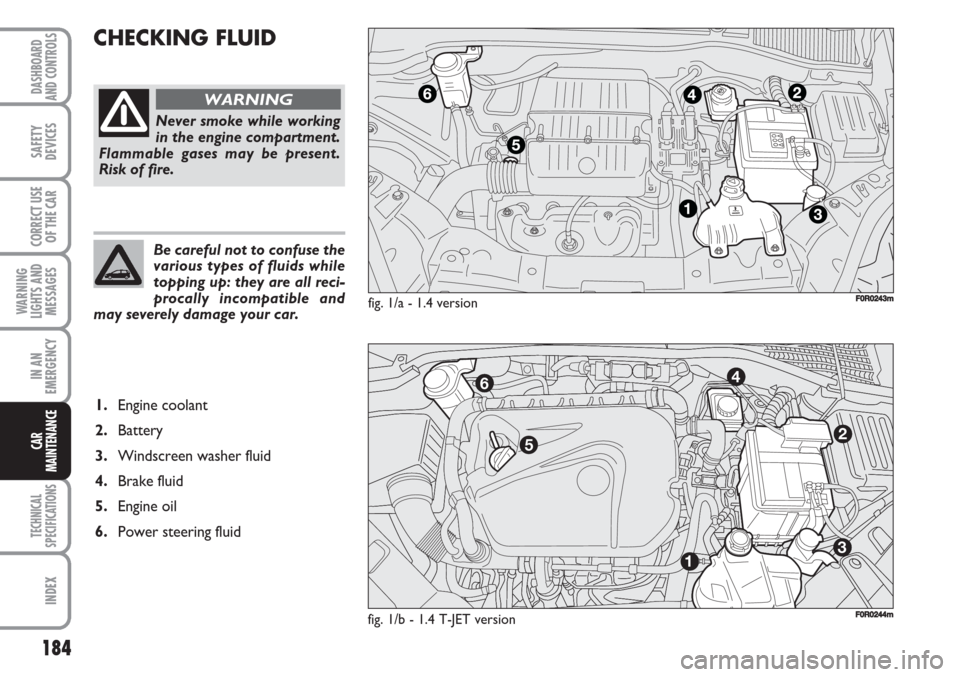
184
WARNING
LIGHTS AND
MESSAGES
TECHNICAL
SPECIFICATIONS
INDEX
DASHBOARD
AND CONTROLS
SAFETY
DEVICES
CORRECT USE
OF THE CAR
IN AN
EMERGENCY
CAR
MAINTENANCE
CHECKING FLUID
fig. 1/a - 1.4 version
Never smoke while working
in the engine compartment.
Flammable gases may be present.
Risk of fire.
WARNING
Be careful not to confuse the
various types of fluids while
topping up: they are all reci-
procally incompatible and
may severely damage your car.
F0R0243m
1.Engine coolant
2.Battery
3.Windscreen washer fluid
4.Brake fluid
5.Engine oil
6.Power steering fluid
fig. 1/b - 1.4 T-JET version
2
64
5
13
2
64
5
13
2
64
5
13
F0R0244m
Page 186 of 230
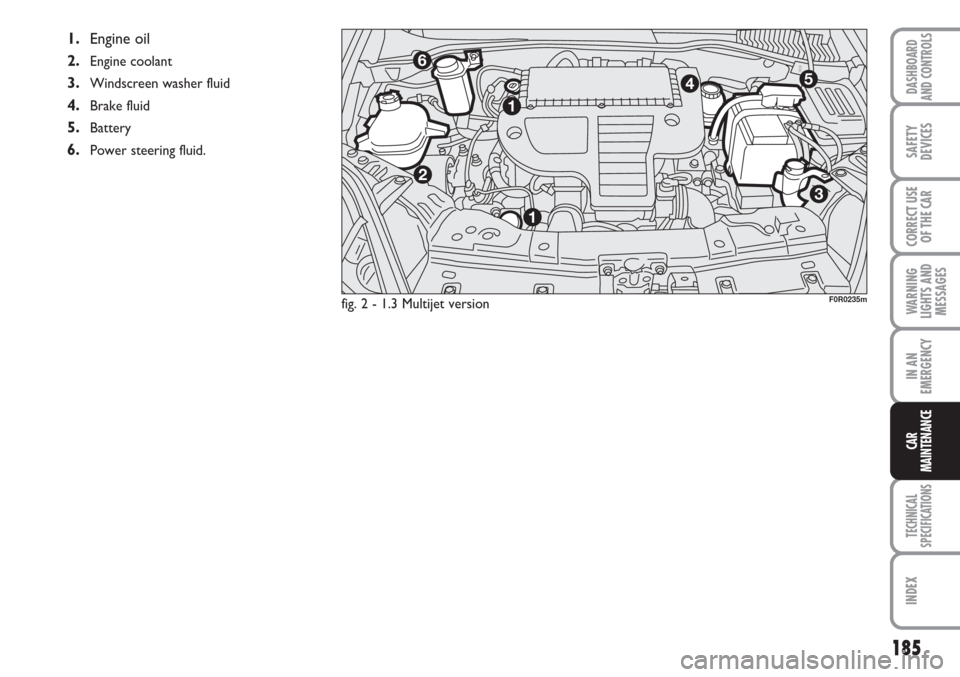
185
WARNING
LIGHTS AND
MESSAGES
TECHNICAL
SPECIFICATIONS
INDEX
DASHBOARD
AND CONTROLS
SAFETY
DEVICES
CORRECT USE
OF THE CAR
IN AN
EMERGENCY
CAR
MAINTENANCE
fig. 2 - 1.3 Multijet version
1
1
6
2
45
3
F0R0235m
1.Engine oil
2.
Engine coolant
3.Windscreen washer fluid
4.Brake fluid
5.Battery
6.Power steering fluid.
Page 187 of 230
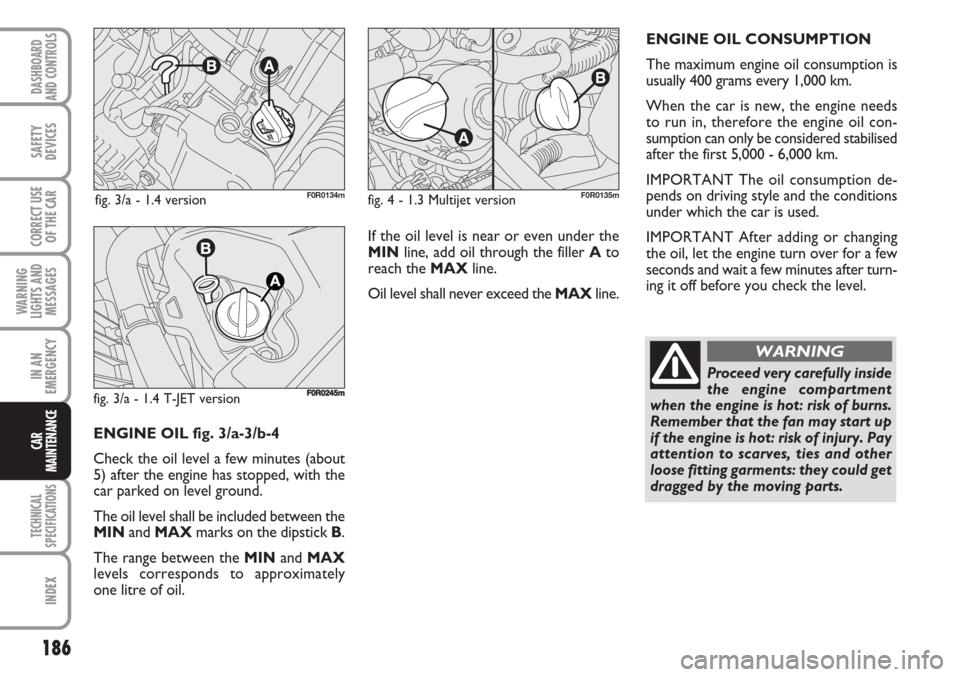
186
WARNING
LIGHTS AND
MESSAGES
TECHNICAL
SPECIFICATIONS
INDEX
DASHBOARD
AND CONTROLS
SAFETY
DEVICES
CORRECT USE
OF THE CAR
IN AN
EMERGENCY
CAR
MAINTENANCE
If the oil level is near or even under the
MINline, add oil through the filler Ato
reach the MAXline.
Oil level shall never exceed the MAXline.ENGINE OIL CONSUMPTION
The maximum engine oil consumption is
usually 400 grams every 1,000 km.
When the car is new, the engine needs
to run in, therefore the engine oil con-
sumption can only be considered stabilised
after the first 5,000 - 6,000 km.
IMPORTANT The oil consumption de-
pends on driving style and the conditions
under which the car is used.
IMPORTANT After adding or changing
the oil, let the engine turn over for a few
seconds and wait a few minutes after turn-
ing it off before you check the level.
ENGINE OIL fig. 3/a-3/b-4
Check the oil level a few minutes (about
5) after the engine has stopped, with the
car parked on level ground.
The oil level shall be included between the
MINand MAXmarks on the dipstick B.
The range between the MINand MAX
levels corresponds to approximately
one litre of oil.
fig. 3/a - 1.4 version F0R0134mfig. 4 - 1.3 Multijet versionF0R0135m
Proceed very carefully inside
the engine compartment
when the engine is hot: risk of burns.
Remember that the fan may start up
if the engine is hot: risk of injury. Pay
attention to scarves, ties and other
loose fitting garments: they could get
dragged by the moving parts.
WARNING
fig. 3/a - 1.4 T-JET versionF0R0245m
Page 188 of 230
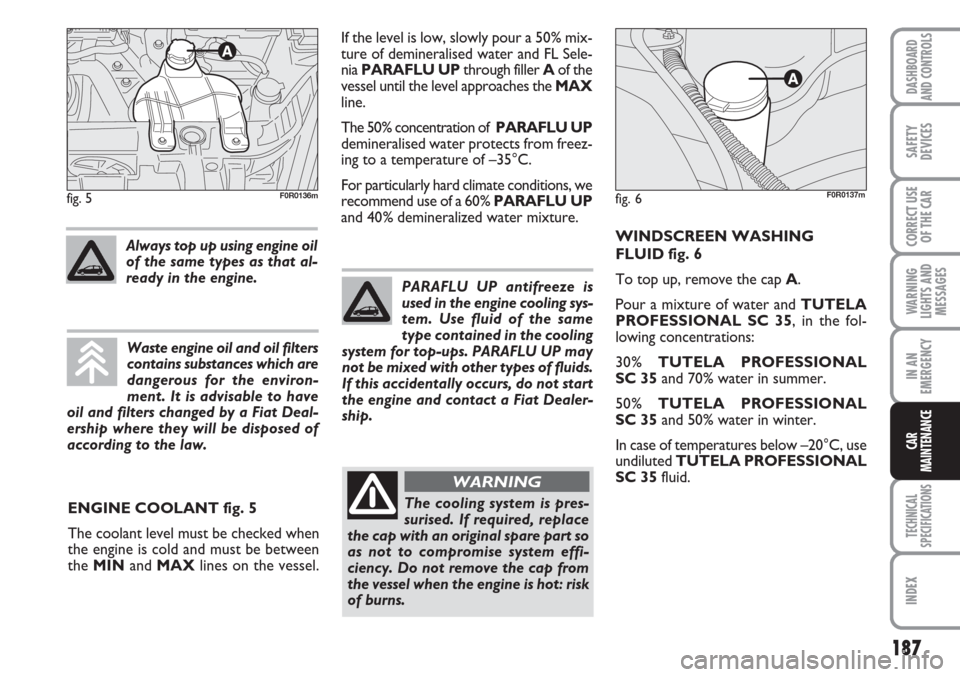
187
WARNING
LIGHTS AND
MESSAGES
TECHNICAL
SPECIFICATIONS
INDEX
DASHBOARD
AND CONTROLS
SAFETY
DEVICES
CORRECT USE
OF THE CAR
IN AN
EMERGENCY
CAR
MAINTENANCE
WINDSCREEN WASHING
FLUID fig. 6
To top up, remove the cap A.
Pour a mixture of water and TUTELA
PROFESSIONAL SC 35, in the fol-
lowing concentrations:
30% TUTELA PROFESSIONAL
SC 35and 70% water in summer.
50% TUTELA PROFESSIONAL
SC 35and 50% water in winter.
In case of temperatures below –20°C, use
undiluted TUTELA PROFESSIONAL
SC 35fluid.
ENGINE COOLANT fig. 5
The coolant level must be checked when
the engine is cold and must be between
the MINand MAXlines on the vessel.
fig. 5F0R0136mfig. 6
PARAFLU UP antifreeze is
used in the engine cooling sys-
tem. Use fluid of the same
type contained in the cooling
system for top-ups. PARAFLU UP may
not be mixed with other types of fluids.
If this accidentally occurs, do not start
the engine and contact a Fiat Dealer-
ship.
The cooling system is pres-
surised. If required, replace
the cap with an original spare part so
as not to compromise system effi-
ciency. Do not remove the cap from
the vessel when the engine is hot: risk
of burns.
WARNING
F0R0137m
If the level is low, slowly pour a 50% mix-
ture of demineralised water and FL Sele-
nia PARAFLU UPthrough filler Aof the
vessel until the level approaches the MAX
line.
The 50% concentration of PARAFLU UP
demineralised water protects from freez-
ing to a temperature of –35°C.
For particularly hard climate conditions, we
recommend use of a 60% PARAFLU UP
and 40% demineralized water mixture.
Waste engine oil and oil filters
contains substances which are
dangerous for the environ-
ment. It is advisable to have
oil and filters changed by a Fiat Deal-
ership where they will be disposed of
according to the law.
Always top up using engine oil
of the same types as that al-
ready in the engine.
Page 189 of 230
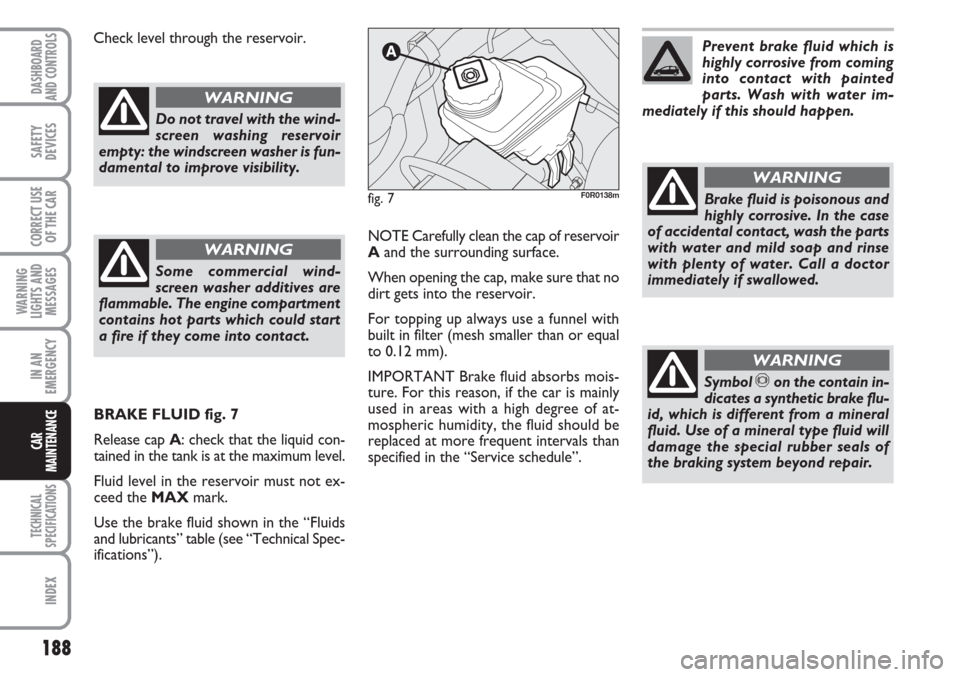
188
WARNING
LIGHTS AND
MESSAGES
TECHNICAL
SPECIFICATIONS
INDEX
DASHBOARD
AND CONTROLS
SAFETY
DEVICES
CORRECT USE
OF THE CAR
IN AN
EMERGENCY
CAR
MAINTENANCE
NOTE Carefully clean the cap of reservoir
Aand the surrounding surface.
When opening the cap, make sure that no
dirt gets into the reservoir.
For topping up always use a funnel with
built in filter (mesh smaller than or equal
to 0.12 mm).
IMPORTANT Brake fluid absorbs mois-
ture. For this reason, if the car is mainly
used in areas with a high degree of at-
mospheric humidity, the fluid should be
replaced at more frequent intervals than
specified in the “Service schedule”. Check level through the reservoir.
fig. 7F0R0138m
Do not travel with the wind-
screen washing reservoir
empty: the windscreen washer is fun-
damental to improve visibility.
WARNING
Some commercial wind-
screen washer additives are
flammable. The engine compartment
contains hot parts which could start
a fire if they come into contact.
WARNING
Prevent brake fluid which is
highly corrosive from coming
into contact with painted
parts. Wash with water im-
mediately if this should happen.
Brake fluid is poisonous and
highly corrosive. In the case
of accidental contact, wash the parts
with water and mild soap and rinse
with plenty of water. Call a doctor
immediately if swallowed.
WARNING
Symbol πon the contain in-
dicates a synthetic brake flu-
id, which is different from a mineral
fluid. Use of a mineral type fluid will
damage the special rubber seals of
the braking system beyond repair.
WARNING
BRAKE FLUID fig. 7
Release cap A: check that the liquid con-
tained in the tank is at the maximum level.
Fluid level in the reservoir must not ex-
ceed the MAXmark.
Use the brake fluid shown in the “Fluids
and lubricants” table (see “Technical Spec-
ifications”).
Page 190 of 230
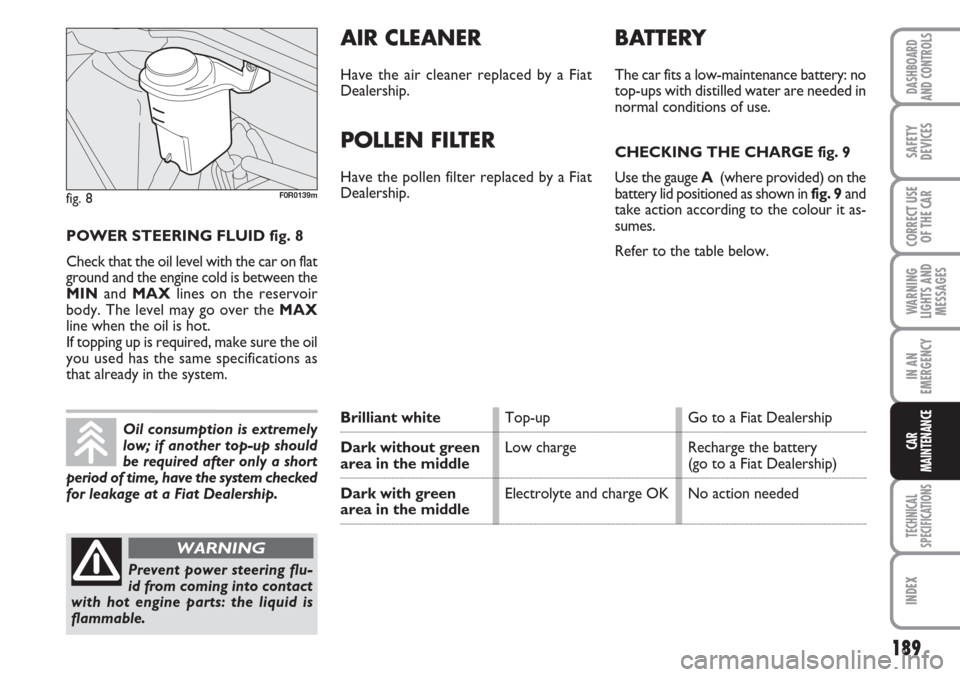
189
WARNING
LIGHTS AND
MESSAGES
TECHNICAL
SPECIFICATIONS
INDEX
DASHBOARD
AND CONTROLS
SAFETY
DEVICES
CORRECT USE
OF THE CAR
IN AN
EMERGENCY
CAR
MAINTENANCEOil consumption is extremely
low; if another top-up should
be required after only a short
period of time, have the system checked
for leakage at a Fiat Dealership.
BATTERY
The car fits a low-maintenance battery: no
top-ups with distilled water are needed in
normal conditions of use.
CHECKING THE CHARGE fig. 9
Use the gauge A (where provided) on the
battery lid positioned as shown in fig. 9and
take action according to the colour it as-
sumes.
Refer to the table below. POWER STEERING FLUID fig. 8
Check that the oil level with the car on flat
ground and the engine cold is between the
MINand MAXlines on the reservoir
body. The level may go over the MAX
line when the oil is hot.
If topping up is required, make sure the oil
you used has the same specifications as
that already in the system.
AIR CLEANER
Have the air cleaner replaced by a Fiat
Dealership.
POLLEN FILTER
Have the pollen filter replaced by a Fiat
Dealership.
Prevent power steering flu-
id from coming into contact
with hot engine parts: the liquid is
flammable.
WARNING
fig. 8F0R0139m
Brilliant whiteTop-up Go to a Fiat Dealership
Dark without greenLow charge Recharge the battery
area in the middle(go to a Fiat Dealership)
Dark with green Electrolyte and charge OK No action needed
area in the middle
Page 191 of 230
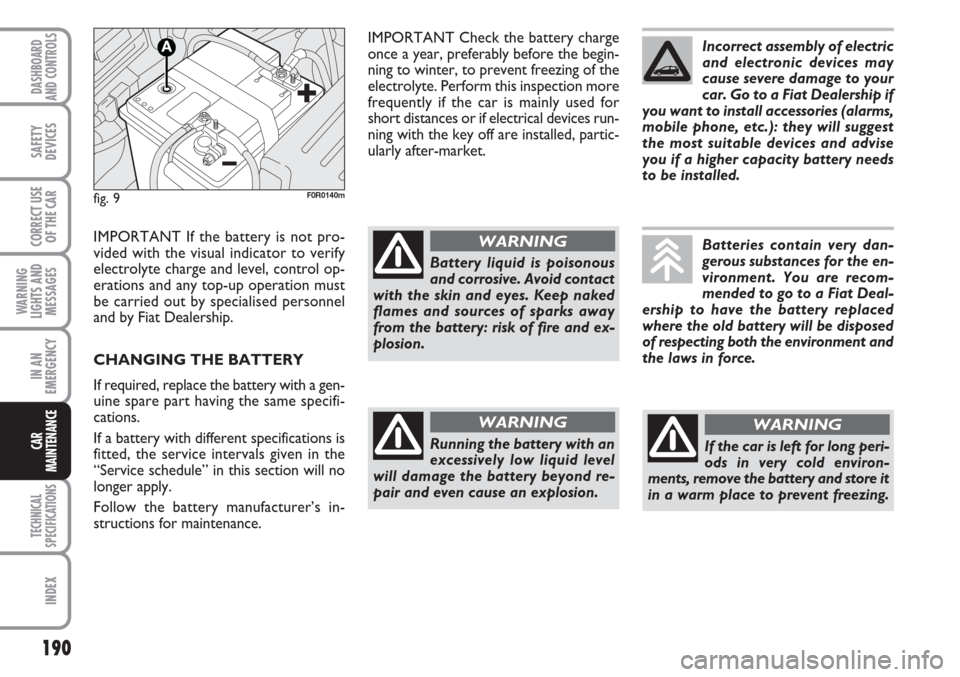
190
WARNING
LIGHTS AND
MESSAGES
TECHNICAL
SPECIFICATIONS
INDEX
DASHBOARD
AND CONTROLS
SAFETY
DEVICES
CORRECT USE
OF THE CAR
IN AN
EMERGENCY
CAR
MAINTENANCE
IMPORTANT Check the battery charge
once a year, preferably before the begin-
ning to winter, to prevent freezing of the
electrolyte. Perform this inspection more
frequently if the car is mainly used for
short distances or if electrical devices run-
ning with the key off are installed, partic-
ularly after-market.
fig. 9F0R0140m
CHANGING THE BATTERY
If required, replace the battery with a gen-
uine spare part having the same specifi-
cations.
If a battery with different specifications is
fitted, the service intervals given in the
“Service schedule” in this section will no
longer apply.
Follow the battery manufacturer’s in-
structions for maintenance.Incorrect assembly of electric
and electronic devices may
cause severe damage to your
car. Go to a Fiat Dealership if
you want to install accessories (alarms,
mobile phone, etc.): they will suggest
the most suitable devices and advise
you if a higher capacity battery needs
to be installed.
Batteries contain very dan-
gerous substances for the en-
vironment. You are recom-
mended to go to a Fiat Deal-
ership to have the battery replaced
where the old battery will be disposed
of respecting both the environment and
the laws in force.
If the car is left for long peri-
ods in very cold environ-
ments, remove the battery and store it
in a warm place to prevent freezing.
WARNING
IMPORTANT If the battery is not pro-
vided with the visual indicator to verify
electrolyte charge and level, control op-
erations and any top-up operation must
be carried out by specialised personnel
and by Fiat Dealership.
Battery liquid is poisonous
and corrosive. Avoid contact
with the skin and eyes. Keep naked
flames and sources of sparks away
from the battery: risk of fire and ex-
plosion.
WARNING
Running the battery with an
excessively low liquid level
will damage the battery beyond re-
pair and even cause an explosion.
WARNING
Page 192 of 230
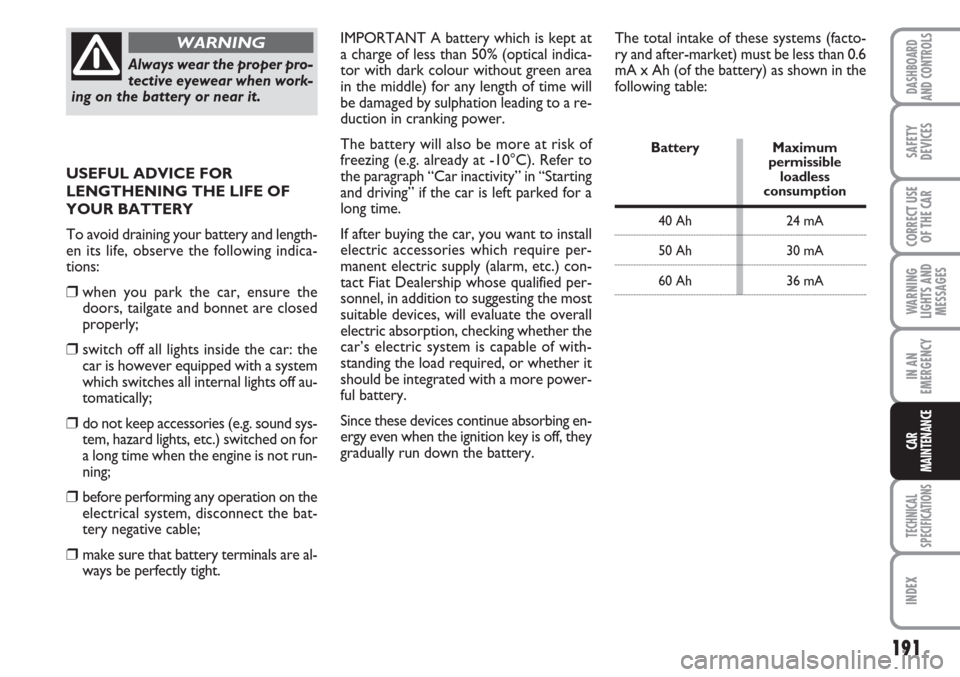
191
WARNING
LIGHTS AND
MESSAGES
TECHNICAL
SPECIFICATIONS
INDEX
DASHBOARD
AND CONTROLS
SAFETY
DEVICES
CORRECT USE
OF THE CAR
IN AN
EMERGENCY
CAR
MAINTENANCE
The total intake of these systems (facto-
ry and after-market) must be less than 0.6
mA x Ah (of the battery) as shown in the
following table:
Battery Maximum
permissible
loadless
consumption
40 Ah 24 mA
50 Ah 30 mA
60 Ah 36 mA
IMPORTANT A battery which is kept at
a charge of less than 50% (optical indica-
tor with dark colour without green area
in the middle) for any length of time will
be damaged by sulphation leading to a re-
duction in cranking power.
The battery will also be more at risk of
freezing (e.g. already at -10°C). Refer to
the paragraph “Car inactivity” in “Starting
and driving” if the car is left parked for a
long time.
If after buying the car, you want to install
electric accessories which require per-
manent electric supply (alarm, etc.) con-
tact Fiat Dealership whose qualified per-
sonnel, in addition to suggesting the most
suitable devices, will evaluate the overall
electric absorption, checking whether the
car’s electric system is capable of with-
standing the load required, or whether it
should be integrated with a more power-
ful battery.
Since these devices continue absorbing en-
ergy even when the ignition key is off, they
gradually run down the battery. USEFUL ADVICE FOR
LENGTHENING THE LIFE OF
YOUR BATTERY
To avoid draining your battery and length-
en its life, observe the following indica-
tions:
❒when you park the car, ensure the
doors, tailgate and bonnet are closed
properly;
❒switch off all lights inside the car: the
car is however equipped with a system
which switches all internal lights off au-
tomatically;
❒do not keep accessories (e.g. sound sys-
tem, hazard lights, etc.) switched on for
a long time when the engine is not run-
ning;
❒before performing any operation on the
electrical system, disconnect the bat-
tery negative cable;
❒make sure that battery terminals are al-
ways be perfectly tight.
Always wear the proper pro-
tective eyewear when work-
ing on the battery or near it.
WARNING
Page 193 of 230
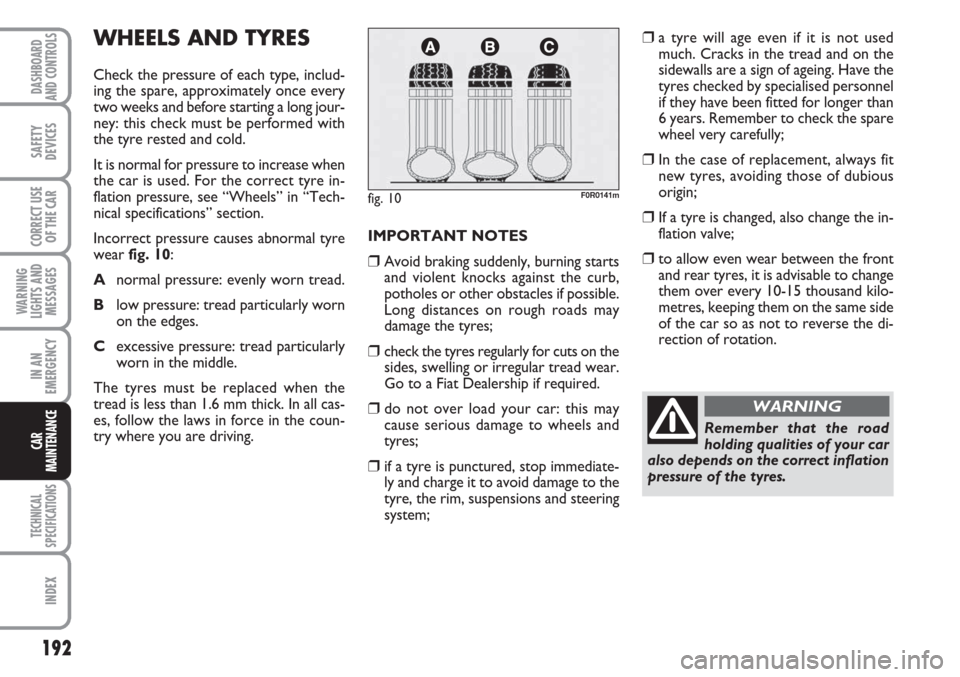
192
WARNING
LIGHTS AND
MESSAGES
TECHNICAL
SPECIFICATIONS
INDEX
DASHBOARD
AND CONTROLS
SAFETY
DEVICES
CORRECT USE
OF THE CAR
IN AN
EMERGENCY
CAR
MAINTENANCE
WHEELS AND TYRES
Check the pressure of each type, includ-
ing the spare, approximately once every
two weeks and before starting a long jour-
ney: this check must be performed with
the tyre rested and cold.
It is normal for pressure to increase when
the car is used. For the correct tyre in-
flation pressure, see “Wheels” in “Tech-
nical specifications” section.
Incorrect pressure causes abnormal tyre
wearfig. 10:
Anormal pressure: evenly worn tread.
Blow pressure: tread particularly worn
on the edges.
Cexcessive pressure: tread particularly
worn in the middle.
The tyres must be replaced when the
tread is less than 1.6 mm thick. In all cas-
es, follow the laws in force in the coun-
try where you are driving.
fig. 10F0R0141m
IMPORTANT NOTES
❒Avoid braking suddenly, burning starts
and violent knocks against the curb,
potholes or other obstacles if possible.
Long distances on rough roads may
damage the tyres;
❒check the tyres regularly for cuts on the
sides, swelling or irregular tread wear.
Go to a Fiat Dealership if required.
❒do not over load your car: this may
cause serious damage to wheels and
tyres;
❒if a tyre is punctured, stop immediate-
ly and charge it to avoid damage to the
tyre, the rim, suspensions and steering
system;
❒a tyre will age even if it is not used
much. Cracks in the tread and on the
sidewalls are a sign of ageing. Have the
tyres checked by specialised personnel
if they have been fitted for longer than
6 years. Remember to check the spare
wheel very carefully;
❒In the case of replacement, always fit
new tyres, avoiding those of dubious
origin;
❒If a tyre is changed, also change the in-
flation valve;
❒to allow even wear between the front
and rear tyres, it is advisable to change
them over every 10-15 thousand kilo-
metres, keeping them on the same side
of the car so as not to reverse the di-
rection of rotation.
Remember that the road
holding qualities of your car
also depends on the correct inflation
pressure of the tyres.
WARNING
Page 194 of 230
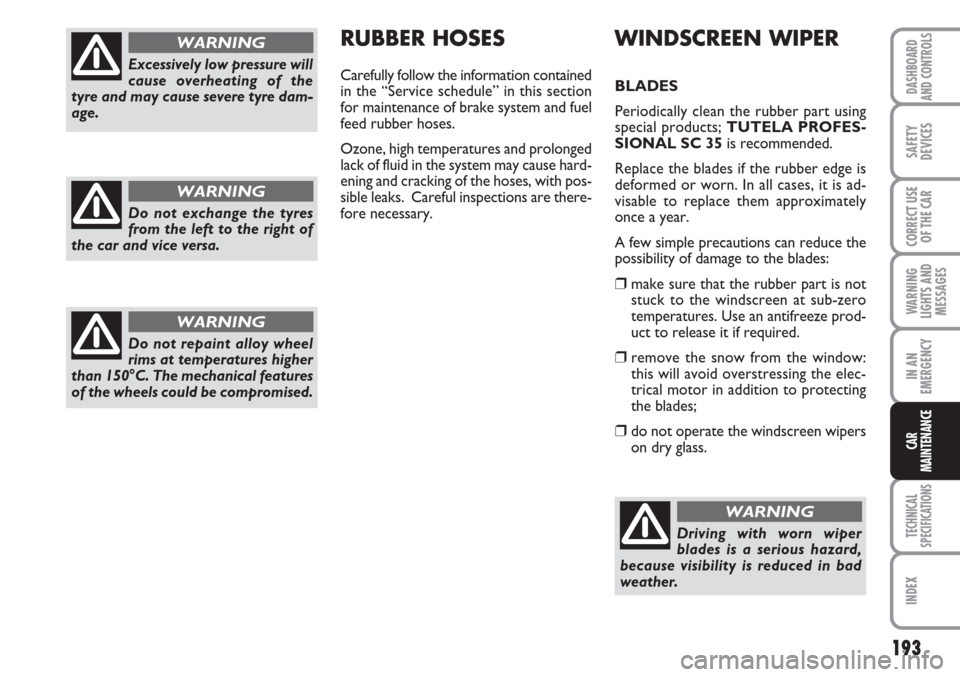
193
WARNING
LIGHTS AND
MESSAGES
TECHNICAL
SPECIFICATIONS
INDEX
DASHBOARD
AND CONTROLS
SAFETY
DEVICES
CORRECT USE
OF THE CAR
IN AN
EMERGENCY
CAR
MAINTENANCE
WINDSCREEN WIPER
BLADES
Periodically clean the rubber part using
special products; TUTELA PROFES-
SIONAL SC 35is recommended.
Replace the blades if the rubber edge is
deformed or worn. In all cases, it is ad-
visable to replace them approximately
once a year.
A few simple precautions can reduce the
possibility of damage to the blades:
❒make sure that the rubber part is not
stuck to the windscreen at sub-zero
temperatures. Use an antifreeze prod-
uct to release it if required.
❒remove the snow from the window:
this will avoid overstressing the elec-
trical motor in addition to protecting
the blades;
❒do not operate the windscreen wipers
on dry glass.
Driving with worn wiper
blades is a serious hazard,
because visibility is reduced in bad
weather.
WARNING
RUBBER HOSES
Carefully follow the information contained
in the “Service schedule” in this section
for maintenance of brake system and fuel
feed rubber hoses.
Ozone, high temperatures and prolonged
lack of fluid in the system may cause hard-
ening and cracking of the hoses, with pos-
sible leaks. Careful inspections are there-
fore necessary.Excessively low pressure will
cause overheating of the
tyre and may cause severe tyre dam-
age.
WARNING
Do not exchange the tyres
from the left to the right of
the car and vice versa.
WARNING
Do not repaint alloy wheel
rims at temperatures higher
than 150°C. The mechanical features
of the wheels could be compromised.
WARNING